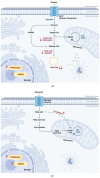The Role of Fucoxanthin in Non-Alcoholic Fatty Liver Disease
- PMID: 37175909
- PMCID: PMC10179653
- DOI: 10.3390/ijms24098203
The Role of Fucoxanthin in Non-Alcoholic Fatty Liver Disease
Abstract
Chronic liver disease (CLD) has emerged as a leading cause of human deaths. It caused 1.32 million deaths in 2017, which affected men more than women by a two-to-one ratio. There are various causes of CLD, including obesity, excessive alcohol consumption, and viral infection. Among them, non-alcoholic fatty liver disease (NAFLD), one of obesity-induced liver diseases, is the major cause, representing the cause of more than 50% of cases. Fucoxanthin, a carotenoid mainly found in brown seaweed, exhibits various biological activities against NAFLD. Its role in NAFLD appears in several mechanisms, such as inducing thermogenesis in mitochondrial homeostasis, altering lipid metabolism, and promoting anti-inflammatory and anti-oxidant activities. The corresponding altered signaling pathways are the β3-adorenarine receptor (β3Ad), proliferator-activated receptor gamma coactivator (PGC-1), adenosine monophosphate-activated protein kinase (AMPK), peroxisome proliferator-activated receptor (PPAR), sterol regulatory element binding protein (SREBP), nuclear factor kappa B (NF-κB), mitogen-activated protein kinase (MAPK), protein kinase B (AKT), SMAD2/3, and P13K/Akt pathways. Fucoxanthin also exhibits anti-fibrogenic activity that prevents non-alcoholic steatohepatitis (NASH) development.
Keywords: fibrosis; fucoxanthin; lipid; liver; non-alcoholic; obesity; thermogenesis.
Conflict of interest statement
Microalgae Ask US Co., Ltd., one of the affiliated institutions of the authors of this paper, is an institution that conducts fucoxanthin-related research with funding from MOTIE and KIMST. Aside from this, the authors have no conflicts of interest.
Figures





References
Publication types
MeSH terms
Substances
Grants and funding
LinkOut - more resources
Full Text Sources
Medical

